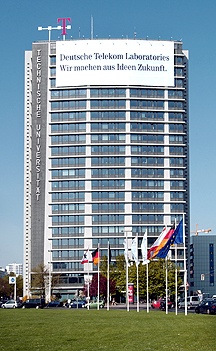Researchers demo 512Gbps over single fibre channel

Deutsche Telekom's research wing has successfully transmitted data over a single optical fibre wavelength at 512Gbps, the company has announced.

Researchers at Deutsche Telekom's T-Labs have successfully transmitted data over a single optical fibre wavelength at 512Gbps. Image credit: T-Labs/Deutsche Telekom
The current maximum bit rate for channels operating in backbone networks is 100Gbps. T-Labs working with Alcatel-Lucent said on Friday that the usable bit rate of the new technology would be 400Gbps per channel.
"While the bar is higher for fibre-optic transmission in a laboratory setting, this record was set under real-world conditions in the Telekom optical network on a route of 734km from Berlin to Hanover and back by speed of light," Deutsche Telekom said.
As T-Labs's system allows for up to 48 channels per optical fibre, the new technology should lead to fibre strands with a theoretical maximum throughput of 24.6Tbps.
Backbone networks are used to inter-network smaller networks, and carry the bulk of national and international data communications. Telecoms companies will bundle many fibres together to support the enormous overall demand of their customers.
"We have a need for more bandwidth in our network. Rapidly growing demand forces us to find solutions for the next step," a Deutsche Telekom spokesman told ZDNet UK.
'Innovative' technology
The T-Labs project that resulted in the new record was called OSIRIS, or 'Optically Supported IP Router Interfaces'. The researchers demonstrated the 512Gbps rate over a 100GHz-wide channel.
"This tremendous transmission performance was reached using innovative transmission technology with two carrier frequencies, two polarisation planes, 16-QAM quadrature amplitude modulation and digital offline signal processing for the equalisation of fibre influences with soft-FEC forward error correction decoding in the receiver," Deutsche Telekom explained.
The team tested the technology alongside conventional 10Gbps channels in the same system, to see how the older technology interfered with the new. The conclusion was that the two types of signal could co-exist.
According to T-Labs, this means it is possible for existing networks to double their current transmission capacities by "merely replacing the technology in the terminal stations", rather than having to lay new cables.
Deutsche Telekom's spokesman told ZDNet UK on Monday that suppliers such as Alcatel-Lucent will now need to develop equipment using the technology. Deutsche Telekom has an infrastructure-sharing deal with France Telecom-Orange, so it will only get to use its creation when its partner buys the equipment.
The spokesman was unable to clarify what intellectual property has resulted from the operator's work with Alcatel-Lucent, nor who owns it.
Get the latest technology news and analysis, blogs and reviews delivered directly to your inbox with ZDNet UK's newsletters.